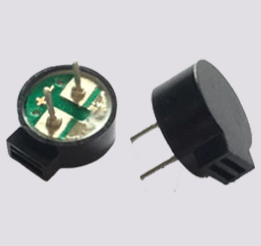Unneglectable Details for Magnetic Transducer Selection
The principle of the electromagnetic transducer is an electroacoustic device that relies on the electromagnetic effect to convert electrical energy into the vibration of the vibrating piece. When a certain frequency of electrical signal passes through the coil inside the buzzer, an alternating magnetic field is generated, and after strengthening the magnetic field through the core support in the middle of the coil, the vibrating piece on the magnet coil is pushed to vibrate.

The key parameters of a general electromagnetic passive buzzer are coil resistance, rated voltage, SPL value, consumption current, voltage operating range, etc.
It is very important for users to do the matching of parameters during the selection, the following is an example of how to do the matching of parameters.
For example, such a buzzer was chosen to be used: first, we know that the rated voltage of this buzzer is 5Vo-p, the input frequency is 2000Hz, the DC resistance of the coil is 42 ohms, the SPL value used under rated conditions is at least 85dB test distance of 10cm, the consumption current is no more than 70mA, and the voltage operating range is 3-7V.
When using this buzzer, the following conditions must be met when designing the circuit.
Buzzer Frequency
The buzzer input signal frequency is 2000Hz is the best. Generally from the CPU I/O port output signal frequency is more accurate. But if you output from elsewhere when the frequency signal error is large, please note a principle.
First, the output signal frequency error range as far as possible to control within 100Hz.
Second, the frequency error design value of the upper tolerance, that is, there must not be a frequency of 2000Hz or less. You can design the frequency of 2000Hz or more to 2100Hz, which basically does not affect the normal use, because, in the frequency of 2000Hz or less input buzzer, some of the buzzers will become very small sound, which is, however, when the buzzer is input at a frequency above 2000Hz, the buzzer’s factory starting point will not be greater than 2000Hz. And the frequency signal exceeding the buzzer’s starting point can make the buzzer vibrate. So it will not be silent, but when the frequency exceeds 2000Hz, the SPL value of some products will drop a little. Generally within 5dB. The listening sensation is not too obvious. If your circuit does not meet the above requirements, you must select a custom buzzer.
Buzzer Amplifier
To drive the amplifier part of the buzzer work, the transistor must be saturated on, that is, the input signal of the amplifier must be enough to drive the transistor saturated on, usually you can adjust the value of the resistor R1 in the circuit to meet.
Resistance Value
The resistance value of the resistor connected in series with the buzzer is not specially required to be replaced by 0 ohms, some users must use the current limiting resistor in order to protect the whole machine, the resistance value of the resistor is also best to use the resistor below 42 ohms, after using the current limiting resistor, the SPL value of the buzzer will have a small drop, usually become a smaller sound value of no more than 5dB.
Operating Voltage
The operating voltage range is 3-7V, the SPL value below 5V will be appropriately reduced, above 5V SPL value will be appropriately increased, users can test the actual SPL value in actual use, below 3V can also be used, but the SPL will be reduced more.
To sum up, the above are the unneglectable details for the selection of a magnetic transducer.


